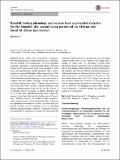Files in this item
Rainfall, leafing phenology and sunrise time as potential Zeitgeber for the bimodal, dry season laying pattern of an African rain forest tit (Parus fasciiventer)
Item metadata
| dc.contributor.author | Shaw, Philip | |
| dc.date.accessioned | 2016-10-03T13:30:11Z | |
| dc.date.available | 2016-10-03T13:30:11Z | |
| dc.date.issued | 2017-01 | |
| dc.identifier | 245995300 | |
| dc.identifier | 62a13a07-ae2d-40f1-9c95-1f27409ad40d | |
| dc.identifier | 85010637358 | |
| dc.identifier | 000393670600025 | |
| dc.identifier.citation | Shaw , P 2017 , ' Rainfall, leafing phenology and sunrise time as potential Zeitgeber for the bimodal, dry season laying pattern of an African rain forest tit ( Parus fasciiventer ) ' , Journal of Ornithology , vol. 158 , no. 1 , pp. 263-275 . https://doi.org/10.1007/s10336-016-1395-6 | en |
| dc.identifier.issn | 2193-7192 | |
| dc.identifier.other | ORCID: /0000-0002-8183-0289/work/143336067 | |
| dc.identifier.uri | https://hdl.handle.net/10023/9597 | |
| dc.description | I gratefully acknowledge financial support received through the British Ornithologists’ Union Small research Grant scheme and from the African Bird Club. | en |
| dc.description.abstract | Recent studies have documented a mismatch between the phenology of leaf production, prey availability and the nestling food requirements of north temperate songbirds, attributed to climate change effects. Although tropical forest species have often been regarded as relatively a seasonal breeders, similar disruptive effects can be expected at equatorial latitudes, where comparatively little is known of the links between weather, leafing phenology, food availability and bird breeding activity, particularly in complex rain forest habitats. During a 19-yr study at 1°S in Bwindi Impenetrable Forest, Uganda, Stripe-breasted Tits Parus fasciiventer showed a strongly bimodal laying pattern, breeding mainly in the two dry seasons, with 50% of breeding activity occurring in January–February and 19% in June–July. Individual females bred in both dry seasons, laying their first and last clutches up to 28 weeks apart. Breeding activity was linked to leaf production, which peaked mainly in November–December, following the September–November wet season. Increased leaf production is likely to have stimulated a rise in caterpillar numbers during December–February, coinciding with peak food demands by nestling tits. Laying was thus positively correlated with increased leaf production in the preceding calendar month, but was also linked to day length and a change in sunset time. To investigate possible links between egg laying and photic cues I compared the median date of first clutches laid by marked females in each half of the breeding year (October–March and April–September), with annual changes in photoperiod (varying by 7 min p.a.) and sunrise time (varying bimodally, by 31 min p.a.). The two median laying dates fell 138–139 days after the last date on which sunrise had occurred at 07:05 in August and January, suggesting the potential for sunrise time to act as a cue, or Zeitgeber, for breeding in tropical birds. Further work is required to establish whether the relationship is causative or coincidental. | |
| dc.format.extent | 692751 | |
| dc.format.extent | 822588 | |
| dc.language.iso | eng | |
| dc.relation.ispartof | Journal of Ornithology | en |
| dc.subject | Stripe-breasted Tit | en |
| dc.subject | Breeding seasonality | en |
| dc.subject | Solar time | en |
| dc.subject | Equatorial | en |
| dc.subject | Tropical | en |
| dc.subject | Montane | en |
| dc.subject | GE Environmental Sciences | en |
| dc.subject | QH301 Biology | en |
| dc.subject | QL Zoology | en |
| dc.subject | NDAS | en |
| dc.subject | SDG 13 - Climate Action | en |
| dc.subject.lcc | GE | en |
| dc.subject.lcc | QH301 | en |
| dc.subject.lcc | QL | en |
| dc.title | Rainfall, leafing phenology and sunrise time as potential Zeitgeber for the bimodal, dry season laying pattern of an African rain forest tit (Parus fasciiventer) | en |
| dc.type | Journal article | en |
| dc.contributor.institution | University of St Andrews. School of Biology | en |
| dc.identifier.doi | https://doi.org/10.1007/s10336-016-1395-6 | |
| dc.description.status | Peer reviewed | en |
This item appears in the following Collection(s)
Items in the St Andrews Research Repository are protected by copyright, with all rights reserved, unless otherwise indicated.


